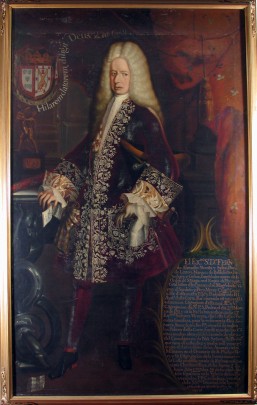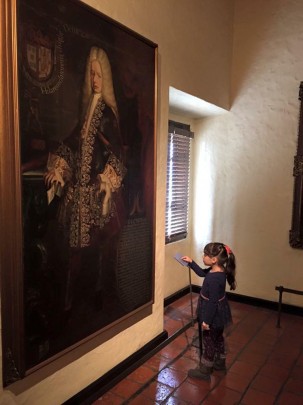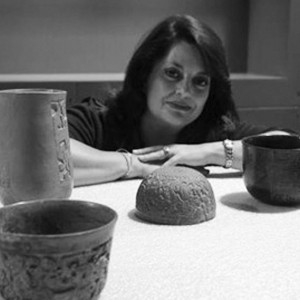One of the masterpieces of the museum’s collection is the portrait of Fernando de Alencastre Noroña y Silva (1641-1717), second Duke of Linares and Viceroy of New Spain, a work that clearly demonstrates the imposition of the Spanish monarchy's order in these lands.
Franciso Martínez, the artist of the work, was born in Mexico City on an unknown date and, like other artists of the eighteenth century, was a very prolific man who, as well as being a great painter, practiced other artistic professions for which he enjoyed great prestige. Among his most notable works from these other professions are the gilding of the largest altarpiece of the Cathedral of Mexico (1743), the construction of the temporary funerary architecture for the death of Philip V in Guatemala (1747), and the subsequent construction of ephemeral architecture for the swearing in of the next king, Ferdinand VI, in Mexico City (1747).
The Viceroy, the Duke of Linares was born on April 15, 1662 in Madrid. He was the son of Agustín de Alencastre Sande y Padilla, Duke of Abrantes and Marquis of Puerto Seguro, and Juana de Noroña y Silva, sister of Miguel de Noroña, Duke of Linares. He was a named Knight of the Order of Santiago, an important honorary and military honor granted by the Spanish crown, and he also acquired thereby the title of Knight Commander of this congregation in Portugal, where his family came from. In 1703, upon the death of his maternal uncle, José Antonio de Noroña, he inherited the Duchy of Linares. Furthermore, he was given the titles of Marquis of Goubea and Count of Portoalegre, and the positions of Gentleman of the King’s Chamber and General of the King’s Armies.
He governed as Viceroy of New Spain from 1711 to 1716 (having previously been Viceroy of Sardinia and of Peru). One of his first tasks was the reconstruction of the Municipal Palace or City Hall in the capital, whcih had been destroyed by a fire in 1692, specifically a fire caused by a popular riot. From this fire, Carlos de Sigüenza y Góngora was able to save, at great personal risk, the historical documents of the City Council. The new viceroy had to face very serious natural disasters, such as an earthquake which shook Mexico city on August 16, 1711, causing serious damage. A couple of years later, there was snowfall over the city, a very rare event, which caused great losses for crops all over the region, and led to hunger and illnesses. It is said that the viceroy distinguished himself by his philanthropy because, like the Archbishop José Lanziego, he was very generous with his own funds during these disasters to help the victims and rebuild the capital of the Viceroyalty.
With regard to culture, the Duke of Linares founded the first public library, as well as the first museum of animals and plants of New Spain. He arranged the writing, composition and staging of the opera "La Parténope," with music by Mexican composer Manuel de Sumaya (1678-1755), which was successfully premiered in the Viceregal Palace on May 1, 1711. This was the first opera performed in North America and the first on the continent by an artist born in the Americas.
He ceded authority over the Viceroyalty in 1716 due to his precarious state of health, and died in Mexico City in June 1717. He was laid to rest in the Church of San Sebastián, then known as the Carmen Monastery.
Nineteen years after his death, readers of the Mexican Gazette read a profile which not only remembered him as a governor, but also as a man who was “very kind, caring and liberal, and so charitable that, in one of the epidemics which infected this kingdom during that time, he appointed four doctors and the same number of pharmacists for relief and recovery of the needy. And most of the churches preserve gifts of his magnificence, several of them being dedicated in the time of his rule.”
The painting which depicts the Viceroy, the Duke of Linares reveals significant features in its quality and style. Baroque easel paintings continued to use, as in the Renaissance period, the technique of oil on canvas. As with the other arts, Baroque painting in New Spain was used to uphold political and religious power. Painting was also used to demonstrate the victory of the monarchy over any attempts at resistance or rebellion, and to highlight the splendor of the Church. This communicated a clear message to the viewer: one sole religion, Catholicism, and one sole king, the King of Spain. This gave rise to what we call the official portrait, when the main figure appears in a rich scene surrounded by drapes and symbolic elements. In this case, the painter recreated a space in which we can see a stained glass window, as well as the shaft and base of a column which served as an architectural backdrop.
In the present painting, the Duke of Linares appears as a man of over fifty. In this full-length portrait in three-quarters profile, the viceroy stands out as the central figure, out of which he stares fixedly at the viewer. The expression of his blue eyes and the pearl tone of his skin mitigate his personality and paleness of his face, which also emphasize the great realism as well as his age and his aquiline nose.
The governor bears a white, puffy, cascading wig, which he was obliged to wear during noble and court ceremonies. This emphasizes and gives a greater sense of realism to his demeanor. He wears a dark red velvet dress coat, closed at the waist, which reaches down to his knees. The rich gold thread embroidery and mixed golden buttons that decorate the front of his attire and back of the sleeve stand out. Due to the influence of French fashion, the Duke of Linares also wears a frilled cravat of fine lace which complements the delicacy of the cuffs.
A little lower down, in his right hand he holds a handwritten document which begins with the abbreviation Exmo Sr (“your excellency”; the form of address for Spanish viceroys), while in his left hand he holds a glove which he has removed from his right hand. Under the left arm, he holds a three-cornered hat with an ochre edge crowned with small white feathers along the border, an accessory which sits close to the straight hilt of a sword. In all of these details, the painter’s ability to reproduce the quality of textures and materials is clear. They have a tactile quality, also noticeable in the embroidered silk stockings, as well as the French-style shoes with red heels and a slender silver spur.
Among the formal characteristics of the Baroque painting, a fondness for realistic naturalism and the use of theatrical scenery resources are notable, meaning the artist perhaps depicts the Duke of Linares in one of the rooms of the Royal Palace of Mexico. In this case, the painter recreated part of one of the rooms by highlighting the opulence of the red drapery on which he displays the subject's coat of arms among the folds of fabric, which descend to the floor where the shaft and base of a column act as an architectural backdrop. Beside him is an inscription offering biographical information, describing the death and burial of the viceroy in June 1717.
The convergence of European elements not only showcases the cultural world of the eighteenth century, but also opens up interesting possibilities for deciphering colonial art.









